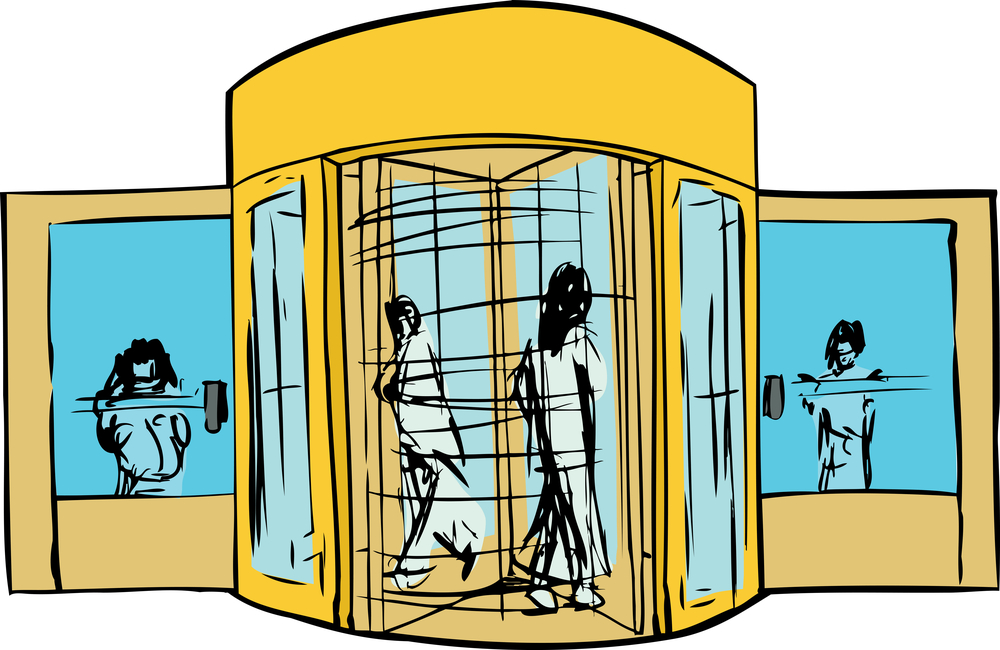A groundbreaking study led by Rachel E. Menzies from The University of Sydney, published in the British Journal of Clinical Psychology, delves into the recurring cycle of mental health issues, known as the ‘revolving door’ phenomenon in mental health services. This study, titled “The ‘revolving door’ of mental illness: A meta-analysis and systematic review of current versus lifetime rates of psychological disorders,” not only sheds light on this pattern but also raises critical questions about the limitations of current diagnostic systems and the effectiveness of psychiatric treatments.
The study’s findings, which show that the average number of lifetime disorders is nearly twice that of current disorders, highlight a disconnect between the current psychiatric approach and the complex, evolving nature of mental health. This insight underscores the pressing need for more adaptive, transdiagnostic treatment methods and a broader understanding of relapse prevention, moving beyond the constraints of traditional psychiatric practices.
“On average, for every disorder someone currently experiences, they will have previously recovered from an equivalent number of different disorders. Importantly, given the mean age of the samples included and the fact that several disorders were not assessed, the true figure is likely even higher. Although further longitudinal studies are needed, the current findings support the notion of the revolving door of mental illness,” the authors write.
“In light of this, potential clinical recommendations from the current findings are as follows: (1) increase focus on transdiagnostic constructs in treatment; (2) broaden the scope of relapse prevention, and (3) increase emphasis on stepped care treatments.”
















Or maybe no one has a disorder and they were just subjected to ongoing, systemic lunacy. I think these experts need to stop saying things like “don’t throw out the baby with the bathwater” and learn other sayings, like “back to the drawing board” or “abolish psychiatry”.
Report comment
They didn’t consider in this study that a patient could become a “revolving door” patient because they were prescribed drugs that caused all of the problems that we now know they cause?
I became a revolving door patient after 6 years of polypharmacy for treatment resistant depression led to ECT which led to a borderline diagnosis which led to the edition of antipsychotics to the psychiatric cocktail.
The system takes people with problems and then creates 100 new problems and then finds a way to blame the patient. “Oh, you had other disorders that we didn’t know about.”
So much for drop the disorder.
Report comment
I was recently on a psych nurse reddit sub where they were talking about “borderlines” on inpatient wards. They were instructing a student nurse on how to “deal with” these patients.
The consensus was: put them on one to one observation but do *not* speak to them (they’re looking for attention. Don’t give it to them. The only reason they should be on 1 to 1 is too prevent them from “acting out”.)
I had a trauma response just reading those comments.
I truly believed, after I’d gotten ECT and a borderline dx at that hospital, that I was “there for help” when I kept winding up back there.
They put me on combinations of drugs that are known to cause akathisia, and when I displayed the symptoms of akathisia, including suicidal ideation, they punished me again.
How dare these people use terms like “revolving door” or “frequent flier”. They’re the ones who made my life a living hell. I’ll never recover from the trauma and illness that they inflicted. How many lives have they ruined?
Report comment
How is ignoring someone supposed to be helpful? That’s just more abuse, which is usually why people end up in the psych hospital in the first place.
Report comment
Sorry that you had to go through this. I was incarcerated and tortured by Psychiatry in 1989 and 1990. There is life after Psychiatry. Hang in there. I’m running for Congress in WVa. One of my planks is to end forced Psychiatry.
Report comment
I think there is life after psychiatry for some but not for everyone. I’ve been away from psychiatrists and psychiatric drugs for over 3 years. I was under some form of psychiatry since 1982 (age 17), ending at age 54. My health has not recovered. I barely leave my apartment and when I do there’s nowhere I feel safe. I am completely isolated and afraid of someone else trying to hurt me, which is statistically likely.
These articles make everything worse. They make me feel more hopeless and more afraid.
Report comment
I have personal experience directly related to this revolving door of Psychiatric care over a 46 year period of time. I’ve also learned & experienced that it is common practice for a Psychiatrist to double the dosage of a med when the prescribed antidepressant stopped working after a year & my symptoms were getting worse again. When the prescribed med was increased, my symptoms became so unmanageable, I ended up in a crisis Center for a week! As we age, our brain changes & many Psychiatrists do not consider this as a fact. My personal experience with Psychiatrists is that the reality of treating mental health IS definitely a revolving door, as there is a high percentage of Psychiatrists who focus more on keeping their patients sick rather than working on getting them well.
Report comment
That’s because psychiatry isn’t medicine; it’s drug dealing.
Report comment
I feel this field, psychiatry …. (Science) in general is so dynamic, no body knows it all. We keep learning and the more knowledge we acquire, we apply the adjustments in the relevant areas. It can never be a one size fits all. This field in particular is complex and demanding.
Report comment
It’s not science.
What does it mean, “we apply the adjustments in the relevant areas?”. Has ECT been banned? Have they stopped drugging children?
If it’s too complex and demanding for them, they should quit. A lot of people would be better off.
Report comment
Psychiatry is not dynamic, it is deadly; the more “knowledge” it acquires, the more damage it does.
Report comment
Looks like psychiatry doesn’t know what the rest of us do: that more made-up “diagnoses” means more lifelong “patients”. So, forget the revolving door. It’s actually a merry-go-round that no one gets off, which (seems to me!) just the way psychiatry likes it.
Report comment
According to the review, it does not appear that treatment of the primary, first, diagnosis prevents the development of a future-related disorder. They argue, probably, it’s because treatment is ineffective not that it is causal to the evolution of future dagnoses, how convenient.
It’s not transdiagnostic enough, apparently.
I think basicaly the cross-sectional nature of the study implies that they missed 3 out of 4? disorders. And even then “normal”? people have more than 1 in somewhat typical succesion.
I thought of this review describing a ladder/stair downwards to more severe diagnoses, but as such, it appears more like a tree than a ladder, with the greeny thing pointing downwards, where 3 out 4 of one’s diagnoses are not recognized at a given point?
I think it all speaks, conservatively, of inflationary diagnosing and the unelaborated “hypothesis”: harm by diagnosis and treatment instead of ineffectivenes by lacking of transdiagnosticity…
Maybe the title should not have been revolving door, but wheel of torture by diagnosis and treatment. Four turns on the wheel would be average?.
And looks odd to me that it starts with the “symptom” most normal of probably all the other pathological symptoms, even cells have it!: stress, now called anxiety. Even computers undergo stress tests, and they don’t come out as anxious from them, let alone depressed or with substance use disorders…
But I guess that with mere rhetoric and divination normal stress and pathological stress is somewhat distinguishable despite the DSM claims otherwise in such expertly, broad and general way that no alternative diagnosis route will achieve said difference in an office, test, survery, etc. And that’sthe first step?… 🙂
Report comment
I think it’s because Szasz was more right than psychiatric practice is. There aren’t “illnesses” of the mind, but rather problems of living. People can have adaptive or maladaptive coping mechanisms; it’s more adaptive when they can restore self-empowerment rather than expecting medications and wards to fix their problems.
Report comment
I guess hence all starts with “anxiety”, before Prozac, callled “stress”.
A normal reaction!, that actually before the 2000s was considered most of the times a normal and usefull reaction: fight or flight…
Start from the normal, the expectable, pathologize it, add a few more disgnostic categories, fuzzy their criteria and, things here and there, we have the current situation: invoke transdiagnostics as another panacea, another way forward, another “research” avenue, another possibility that “might” work…
Report comment
Exactly. Psychiatry’s “illnesses of the mind” mantra is a myth. Their drug “treatments” create a revolving door because their drugs don’t “treat” anything; they simply mask people’s problems instead of exploring what Dr. Szasz accurately called “problems in living”.
The fact is that psychiatry’s so-called “medications” often cause debilitating side effects that, to a lot of practitioners, look like “symptoms” of another “psychiatric disorder”, or, when people try to stop taking them, cause withdrawal that often gets labeled as relapse of the original “illness”, or worse yet, signs of ANOTHER “illness” for which EVEN MORE drugs are added to “treat”.
This why psychiatry is not a legitimate medical specialty. All it does is create an endless cycle of drug dependence for non-existent “illnesses”.
Report comment
“Adaptive” and “maladaptive’ behaviors are definable only in a specific cultural context at a particular moment in time, and have nothing to do with medicine or science.
Report comment
Very true. What’s adaptive for one person may be not be for another.
Report comment
I believe Szasz defined it based on the individual client’s conception of adaptive and maladaptive. I wrote an article around a similar topic recently on here, discussing who defines impairment and how it gets used in society.
Report comment
Actually no.
In evolutionary terms a malapdaptive behaviour is one that decreases the reproductive sucess of your descendants, not yours. Being smart, social mammals with relative long lifves, most of which “we” can’t breed any more.
It might come maladaptive to be labeled “schizo” if you don’t have “enough” progeny, compared to competitors, but I think we can elaborate where that comes from. And that stopped being about reproduction at all!. 10-16 descendants families are things of the past.
There is not much natural about social evolution…
And there is the issue that not many people care about their descendants, and many of those folks are in directive positions. But, that could be another reproductive sucess strategy, not an evolutionary one…
So maladaptive as a concept with evolutionary grounding, does not apply very well to the social or familial realm.
Adaptation is about survival of the next generation, not one’s own. That’s evolutions 101, it’s the mutation that improves reproduction of the descendants of the mutated one.
In human evolution there is the “shared” mutation, next of kin survival, but it’s not mainstreamy: why would my brother have 20 kids when I got none?, sort of thing.
Report comment
The brain energy theory and metabolic approach to mental illness is what saved my life.. Mental illness should more accurately be referred to as neurometabolic dysfunction. Metabolic therapies like the ketogenic way of eating should be the standard of care. The psychiatric system does nothing in the way of addressing root cause and therefore cures no one and often promotes the worsening of these disorders and degeneration of overall health. For further information please read “Brain Energy” by Dr Chris Palmer, “Change Your Diet, Change Your Mind” by Dr Georgia Ede, and visit the Stanford Clinic for Metabolic Psychiatry website led by Dr Shebani Sethi. My lived experience bipolar recovery story can be found on BipolarCast episode 11 on YouTube. I currently help others get off medication and put bipolar into remission. I’ve been in remission for almost 6 years with no medication.
Report comment
This news needs to get out. I found the info via metabolicmind.org & read BRAIN ENERGY by Dr. Chris Palmer & DrGeorgia Ede’s book CHANGE YOUR DIET CHANGE YOUR MIND. Our son, who has been very psychotic 24/7 for 7 years is on keto diet now. Hoping & praying for recovery.
Report comment
You did not consider the fact that mental health providers of all kinds in any setting can easily blame their patients for not achieving any remission or rehabilitation goals. You did not address the fact that mental health providers of any kind in any setting are not forced to “prove results” of their treatment.
Mental health providers can easily exploit doing absolutely nothing day in and day out year after year after year. The problem rests with mental health providers who are not closely supervised and can blame their patients for their in adequate success. The problems rest in mental health providers and the lack of oversight to see if they really tried in any way at all to help their patient.
Facilities and providers should have some measure to evaluate their rate of readmissions versus their rate of rehabilitation and remission of symptoms
There is a ginormous percentage that has nothing to do at all with your study. It all has to do with mental health providers and those who run facilities and have absolutely positively no oversight to see if they did anything at all to try and actually get their patient into remission of symptoms or rehabilitation. All you had to do was ask mental health patients why they aren’t getting better. And they would tell you that they are embarrassed, humiliated, re-traumatized, triggered, and lied about by their mental health providers. You missed a whole subset of reasons people do not reach any mental health treatment goals.
And you also did not seem to mention that there is not enough trauma informed providers in any setting anywhere. Clearly anyone who is involved in the initial study and decided what would be looked at does not have any mental health issues and has not received any mental health services.
You did not have anyone with “lived experience” on THE TEAM, versus being your rats, did you?
Report comment
Well said, Dee. They need only speak to us, their test subjects, to find the answers they seek. It’s not a mystery why people do poorly in this system if you open your eyes and ears.
Report comment
I think you meant, “They need only LISTEN to us, their test subjects, to find the answers they seek.”
Your next comment, describing the typical iatrogenic illness creation process of likely most psychiatrists, is spot on, however, Kate L.
Report comment
Yes, thank you for the correction. They need to stop speaking and listen.
Report comment
They aren’t seeking any answers.
If they were, they would have found out a long time ago their method to seeking answers won’t provide one.
Their method is unscientific, pseudoscientific, callous, cruel, inhuman, etc.
Is it because they couldn’t see it?. Really?, posgraduates that can’t search for the truth aren’t asking questions…
They really have no doubts: they just do what they like…
Report comment
I would like to know who paid for this study. I don’t see anything groundbreaking about it. Did they consider the fact that none of these disorders are real? Did they consider that a patient can be diagnosed with depression or anxiety disorder and then put on SSRIs, have a manic episode and then get a bipolar disorder diagnosed? Did they consider the fact that that patient when they then begin to question their treatment and whether there is any validity at all to what their treatment providers are telling them can then get a borderline personality disorder diagnosed?
We keep hearing about a paradigm shift only to get more of the same. I don’t see anything groundbreaking about this study.
Report comment
I recently started seeing a NP who works with the homeless because as a autistic I figured she’d take me more seriously about issues and be used to “difficult” patients. She was but it really concerned me that she claims to have no experience with autistic patients. It is estimated that at least 12% of the homeless are probably autistic. So I can only assume the mental illness folks keep those patients on an endless programs destined to fail because their autism is not recognized or addressed. I know my friend is going through this. They keep her in day programs singing Kumbiya and placing her in jobs that she keeps failing at. After 2 years of suggesting that she might be autistic like me she eventually found a therapist that agreed with me. But they still have her in the day program and insisting she needs intensive PTSD work that they are happy to provide infinitum. So she hasn’t made any progress. Isn’t the system supposed to work better than this?
Report comment
No. It’s supposed to parrot the party line of “lifelong treatment for biological brain disorders” which means lifelong job security for them.
Report comment
https://images.app.goo.gl/WSdzr9jJnxDjD7cz8
I decided to use the old “benefit of the doubt” skill and looked up this HiTop thing that’s being proposed as an improvement over the DSM and OMG the language is even worse — more pathologizing, more patient-blaming/shaming, really “saying the quiet part out loud” as the kids say.
Ex., the replacement for borderline personality appears at the far right of the diagram.
We’re going in the wrong direction!
https://www.apa.org/pubs/highlights/spotlight/issue-88#:~:text=Finally%2C%20unlike%20DSM%E2%80%935%2C,risk%20factors%2C%20and%20neurobiological%20abnormalities.
The APA claims that HiTop is “more scientific” than DSM. And yet HiTop has ratings for “flirtatiousness”, for “attention seeking behavior”, for “maliciousness”.
(“Finally, unlike DSM–5, the HiTOP project adheres to the most up to date scientific evidence, rather than relying on expert opinion”)
In what world is this science? I’m honestly starting to worry about these people. They seem to have lost touch with reality.
Report comment
“…really saying the quiet part out loud…”
Thank you for the links, KateL. Seeing diagrams like this is scary, but it shows how the American Psychological Association is no better than American Psychiatric Association.
Report comment
Yes, Birdsong, it really is scary. Scary that none of the people who worked on HiTop saw a problem with a concept like “pathological flirtatiousness”.
Worse yet, they consider it to be objective and scientific. “Tendency to fraud” — as in prescribing harmful drugs based on bogus diagnoses and saying that the drugs are safe and effective and cure chemical imbalances?
Report comment
They should have just called it “Psychology’s Book of Sins”.
Report comment
Is there REALLY such a diagnosis as “pathological flirtatiousness?” Who concocted that disorder, and where is the precise line dividing supposedly healthy vs morbid flirtatiousness? I imagine that in Saudi Arabia or Iran, for example, the mere removal of a hijab in public for a mere second could be construed as a sign of gross sexual immorality and be subject to severe penalties. These totally subjective categories of mental illness or dysfunctional thinking are simply medicalized descriptions of socially disapproved conduct, with no legitimate connection to science or medicine.
Report comment
They are in some ways worse. They benefitted for the last 4 decades from the expanded DSM, the explosion in diagnosing and drugging — and now they come out with something more pathologizing than the DSM and try to pass it off as objective and scientific.
Report comment
HiTop is a hideous document: no context, no compassion.
Report comment
Good alternatives to the DSM are, for example, the PTMF and the ITIM, not a pathologizing manual like HiTop.
We are AGAINST the pathology paradigm, not looking for better ways to exercise shame-based coercion on people who are trying to survive late-stage capitalism.
Report comment
I can’t stop thinking about this article. It reminds me of the Jim Phelps article proposing a theory that some people have trouble with psych drug withdrawal because they have something called bipolarity (if I have summarized accurately).
Both articles share a theme of first acknowledging the fact that many people who encounter the mental health system do poorly, and then finding the answer to this conundrum in the idea that the patient has more pathologies than were first recognized.
Report comment
Short and sweet article. Didn’t try to read the study.
(1) increase focus on transdiagnostic constructs in treatment.
The “treatments” I am learning require no traditional diagnosis at all.
(2) broaden the scope of relapse prevention.
This is the problem of Ethics. Keeping people away from “friends” who wish them harm. These “friends” may include therapists!
(3) increase emphasis on stepped care treatments.
1. Ethics.
2. Drug withdrawal.
3. Basic study skills.
4. Follow a standard set of treatment steps.
This system already exists, but not in the public sector.
Report comment
If there were any doubt this article proves MIA is for “professionals” who get paid to come up with creative new ways to abuse people while using words like “groundbreaking” and “paradigm shift.”.
I’m glad my life is almost over thanks to what these monsters did.
Report comment
Don’t forget “nuance”; it’s the professional obfuscators’ favorite word.
Report comment
Right…I need to understand that this is a nuanced and highly complex subject and that “science isn’t perfect/it’s always learning!”
Report comment
I’ll never understand people’s worship of “science”. It has no place in situations having to do with peoples’ subjective, (“nuanced”) experience.
Report comment
There cannot possibly be a legitimate “paradigm” for the mental health industry, which, like debunked pseudosciences such as phrenology, is essentially a gigantic profit-making cult based on a false premise, i.e. thoughts, emotions, and behaviors can be properly categorized as healthy or pathological in a verifiable medical sense. Once this premise is understood, deconstructed, and rejected, the entire sham ought to fall apart. Unfortunately, the interests of too many players–the legion of so-called mental health professionals, the pharmaceutical industry, venal journalists and academicians–are at stake in this charade. Hence its continued survival and ever-expanding scope, as we can see in the pervasive drugging of schoolchildren, or of elderly patients in nursing homes, to make them more amenable to “authority.”
Report comment